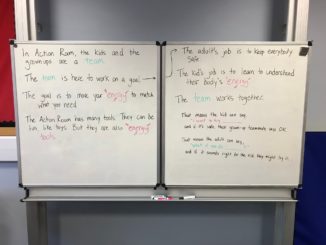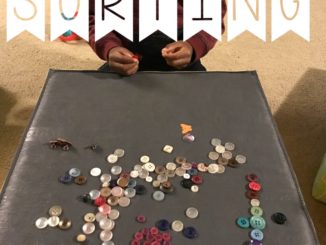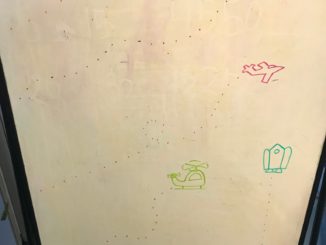So last week I wrote about my mailbox project with four classes at the schools I work in — 4th grade, 3rd grade, 3rd grade, and 1st grade (or approximately age 9-10, 8-9, and 6-7).
I’m going to break down what I wrote for each of the grades, and why.
I am not a literacy expert and I am a huge proponent for kids to learn to read and write at their own pace — often a slower pace than the United States school system pushes, because I see how much it’s stressing out the kids I work with. However, some of the things I wrote in the notes might’ve been above kids’ reading levels. I aimed for their reading level but also for being interesting enough for them to want to read or care about. (After all, if I just wrote them notes that were like, “Bob is a cat, hi Bob,” that wouldn’t make any sense or be that interesting.) I didn’t think that it would be a problem if I wrote things that were slightly higher than they could read at, because I don’t think it’s a problem for them to ask for help or have the teacher or a friend read part of it to them.
Remember that my overall goal with this entire project is to create a reason for writing to be authentic and delightful and completely optional and also adult-modeled. To model why someone (me) might write something for joy and delight and not at all because they’re academically required to.
***
With the first graders, with a “delight and joy” focus in mind, and intentionally keeping very simple language, I used fun “extras” to try to accomplish that goal. I have cute little sticky note tabs and I decided to use these to jazz up my card. I put 2 of them on each card, one for the student to keep and one for the student to write their name on and return it to me (if they chose). I figured that almost every, if not every, student in the classroom would likely be able to write at least their name by now. If all I got was a name on a sticky note plus a drawing or doodle or colors, then that was some awesome engagement and rapport-building!
You can see from the pictures that my language changed a few times as I tried to settle on the simplest, clearest, most easy-to-read language that I could to convey this concept.
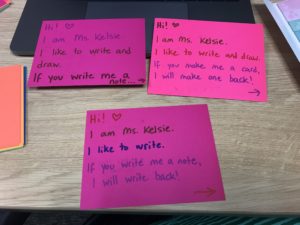
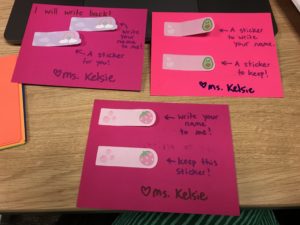
A transcription of the first-graders’ cards:
“Hi! (drawn heart) I am Ms. Kelsie. I like to write and draw. If you write me a note…/If you make me a card… I will write back!”
Then on the back it reads, “A sticker to write your name/ Write your name to me.”
“A sticker to keep!/Keep this sticker!/A sticker for you!” as, like I said, I was trying to figure out the best way to write in the shortest, fewest, clearest words. The stickers are little sticky-note tabs with cute things on them like a little strawberry, a smiley avocado, and a rainbow. (Others I gave them, not pictured, have a smiley face, a butterfly, a flower, or a swirly shape.)
***
For my third graders, again, with a “delight and joy” focus and a little bit more ability to write more words, I used the concept of drawing something silly, fun, and novel to accomplish that goal. I had 2 third-grade classes for a total of 35 kids, and I drew a different ridiculous doodle on each card! In the text of the card, I asked them to tell me something to draw them in future mail. Again…I figured this would solicit some rapport and engagement from the kids who were interested.
I wrote my sentences in alternating pen colors for a little bit of visual distinction between sentences. In the pictures, some of them are hard to read. In real life, they are easier to see. The pens I used were cool and metallic, and caused a shiny reflection in the photos that does exist in real life but is easier to compensate for depending on what angle you look at the card from.
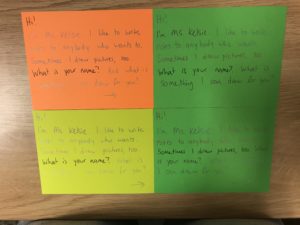
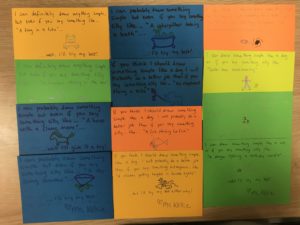
A transcription of the third-graders’ cards:
“Hi! I’m Ms. Kelsie. I like to write notes to anybody who wants. Sometimes I draw pictures, too. What is your name? And what is something I can draw for you?”
On the back, I again experimented with the language I used to convey my concept, but in general it says something like, “I can definitely draw anything simple. But even if you say something silly like… [silly thing],” Then there is a drawing of the silly thing I named, then it says “…well, I’ll try my best!” and is signed by me.
Some examples of the silly things I drew:
-A frog in a tutu
-A dinosaur playing in the rain
-A horse with a flame mane
-A sky-diving dinosaur
-A caterpillar taking a bath
-An elephant flying a kite
-A fish playing Go Fish
-A chicken getting tangled in twinkle lights
-A rocket trying to escape a black hole
-Spider-Man skateboarding
-A unicorn jumping over a rainbow
-A dragon lighting a birthday candle
***
With my fourth graders, I focused on the written word — the only doodles I drew were entirely supplemental (rather than the focus of a sentence), and not every card had a doodle on it.
Instead, again going for the way that writing can be used for self-expression, delight and joy, I wrote fun facts about myself (with the hope, though not insistence, that the kids might write fun facts to me back about themselves). I tried to consider what would’ve been interesting to me to hear about an adult when I was like 10 years old — it was surprisingly harder than I thought because I definitely didn’t want to repeat the same three facts for everybody. I did have some repetition of facts (one of my facts was always that I have rainbow hair, so that they could recognize me out and about!) but for the most part I had variance of facts for all the kids. If I could remember fun facts about myself from 4th grade specifically, I made sure to include those on a few cards.
On the back I got very earnest, while also being as kid appropriate of language as I could, with my opinion on children: that they’re delightful, creative, incredible, amazing and I love spending my life working with them! I didn’t say exactly that but I did gush a bit. I figure if nothing else, every kid going home and knowing there’s an adult out there who believes in them and is cheering for them, even if they never write me a word in reply, is a really good thing.
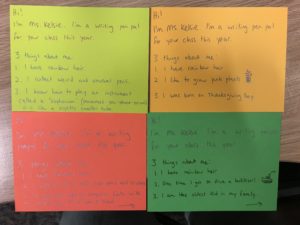
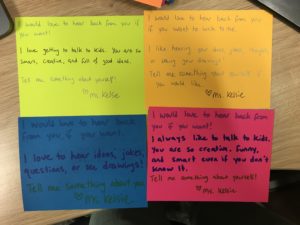
A transcription of the 4th graders’ cards:
On the front it says, “Hi! I’m Ms. Kelsie. I’m a writing pen pal for your class this year.
3 things about me:”
Then it names 3 things.
Here are some of my facts that I used (some pictured, some not):
-I have rainbow hair. (This was always my first one)
-I collect weird and unusual pens.
-I know how to play an instrument called a “euphonium” (pronounced: you-phone-ee-um). It is like a slightly smaller tuba.
-I like to grow pink plants.
-I was born on Thanksgiving Day.
-When I was in 4th grade, I got my first pet. It was a cat.
-I’m good at copying computer fonts with my handwriting. It is a weird talent.
-One time I got to drive a bulldozer.
-I am the oldest kid in my family.
-I like to write stories.
-When I was in 4th grade, my favorite video game was Animal Crossing.
-One time I hula hooped for 45 minutes without stopping.
-I love cats and chocolate.
-When I was in 4th grade, I cracked my head open. (I do not recommend this.)
On the back, it says, “I would love to hear back from you if you want! [Then a positive message.] Tell me something about yourself if you would like! Love, Ms. Kelsie.”
Some examples of positive messages I used:
-I love getting to talk to kids. You are so smart, creative, and full of good ideas.
-I love hearing your ideas, jokes, thoughts, or seeing your drawings!
-I always like to talk to kids. You are so creative, funny, and smart even if you don’t know it.
-I love to hear from kids. I think they have more creative ideas than adults do 🙂
***
Last week I got to go around to all the classes and actually deliver my mail for the first time. I’ll keep you all posted on how it goes!

